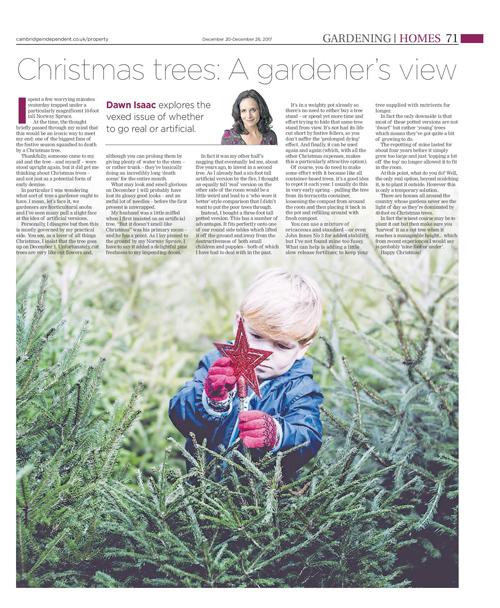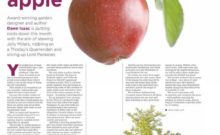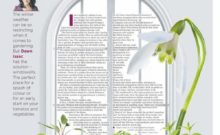I spent a few worrying minutes yesterday trapped under a particularly magnificent ten foot tall Norway Spruce.
At the time the thought briefly passed through my mind that this would be an ironic way to meet my end: one of the biggest fans of the festive season squashed to death by a Christmas tree.
Thankfully, someone came to my aid and the tree – and myself – were stood upright again, but it did get me thinking about Christmas trees – and not just as a potential form of early demise.
In particular I was wondering what sort of tree a gardener ought to have. I mean, let’s face it, we gardeners are horticultural snobs and I’ve seen many pull a slight face at the idea of artificial versions.
Personally, I disagree but then this is mostly governed by my practical side. You see, as a lover of all things Christmas, I insist that the tree goes up on December 1st. Unfortunately, cut trees are very like cut flowers, and, although you can prolong them by giving plenty of water to the stem – or rather trunk – they’re basically doing an incredibly long ‘death scene’ for the entire month. What may look and smell glorious on December 1st will probably have lost its glossy good looks – and an awful lot of needles – before the first present is unwrapped.
My husband was a little miffed when I first insisted on an artificial tree. “But it doesn’t smell like Christmas” was his primary moan – and he has a point. As I lay pinned to the ground by my Norway Spruce I have to say it added a delightful pine freshness to my impending doom.
In fact it was my other half’s nagging that eventually led me, about five years ago to invest in a second tree. As I already had a six foot tall artificial version by the fire, I thought an equally tall ‘real’ version on the other side of the room would be a little weird and lead to a ‘who wore it better’ style comparison that I didn’t want to put the poor trees through.
Instead, I bought a three-foot tall potted version. This has a number of advantages. It fits perfectly onto one of our round side tables which lifted it off the ground and away from the destructiveness of both small children and puppies – both of which I have had to deal with in the past. It’s in a weighty pot already so there’s no need to either buy a tree stand – or spend yet more time and effort trying to hide that same tree stand from view. It’s not had its life cut short by festive fellers, so you don’t suffer the ‘prolonged dying’ effect. And finally, it can be used again and again (which, with all the other Christmas expenses, makes this is particularly attractive option).
Of course, you do need to make some efforts with it because like all container-based trees, it’s a good idea to repot it each year. I usually do this in very early spring – pulling the tree from its terracotta container, loosening the compost from around the roots ,and then placing back in the pot and refilling around with fresh compost. You can use a mixture of ericaceous and standard – or even John Innes no. 3 for added stability, but I’ve not found mine too fussy. What can help is adding a little slow release fertiliser, to keep your tree supplied with nutrients for longer.
In fact the only downside is that most of these potted versions are not ‘dwarf’ but rather ‘young’ trees which means they’ve got quite a bit of growing to do. The repotting of mine lasted for about four years before it simply grew too large and just ‘lopping a bit off the top’ no longer allowed it to fit in the room.
At this point, what do you do? Well, the only real option, beyond mulching it, is to plant it outside. However this is only a temporary solution. There are houses all around the country whose gardens never see the light of day as they’re dominated by forty foot ex-Christmas trees. In fact the wisest course may be to plant it out but then make sure you ‘harvest’ it as a cut tree when it reaches a manageable height… which from recent experiences I would say is probably ‘nine foot or under’.
Happy Christmas!






